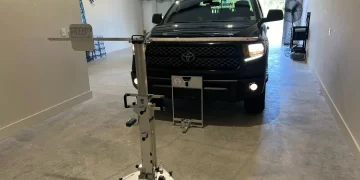When driving a car, two essential parameters that significantly affect how the vehicle handles and how comfortable the driving experience is are steering angle and turning radius. While both terms are related to a car’s ability to maneuver, they refer to distinct aspects of vehicle steering, and each plays a role in how easy it is to navigate, park, and make turns. Understanding these concepts can help you appreciate the engineering that goes into vehicle design and how they impact day-to-day driving.
1. What is Steering Angle?
The steering angle refers to the angle at which the front wheels of a vehicle are turned in response to the driver’s input via the steering wheel. It directly affects the trajectory of the vehicle and how sharp or wide the turns are. In essence, the steering angle dictates how much the wheels will deflect to either side when the steering wheel is turned.
- Higher steering angle: When the steering angle is more significant (i.e., the front wheels turn more sharply), the vehicle can navigate tighter turns more easily, but it may require more effort from the driver to keep control, especially at higher speeds.
- Lower steering angle: A smaller steering angle indicates that the wheels aren’t turning as much, which generally results in smoother, less responsive turning, and better stability at high speeds.
Key Factors Influencing Steering Angle:
- Steering system design: In traditional systems, the steering angle depends on the linkage between the steering wheel and the wheels. In modern vehicles, electric power steering (EPS) can make the system more responsive by adjusting the steering angle depending on vehicle speed and road conditions.
- Wheel alignment: Proper wheel alignment is critical for ensuring that the steering angle leads to optimal handling and that the car does not pull to one side while driving.
Impact on Driving Experience:
- Maneuverability: The steering angle determines how easily a car can maneuver, especially when navigating tight spaces like parking lots or U-turns. A higher steering angle enables sharper turns, allowing for more agile handling in urban environments.
- Handling at high speeds: While a larger steering angle improves maneuverability at low speeds, a smaller angle is often preferred for high-speed stability, where less sharp turning minimizes the risk of oversteering or understeering.
- Driver comfort: Cars with highly responsive steering, typically resulting from larger steering angles, can feel more engaging to drive. However, it can be less comfortable during long-distance drives or when making frequent adjustments to the wheel.
2. What is Turning Radius?
The turning radius (also known as the turning circle) is the smallest circular turn that a car can make when the steering wheel is turned to its maximum angle. In other words, it represents the minimum space needed for a car to make a complete U-turn without hitting obstacles or going off-course.
The turning radius is a crucial metric for determining how well a vehicle can navigate confined spaces such as tight city streets, parking lots, or garages. It is usually measured in meters and is affected by several factors, including the car’s wheelbase (the distance between the front and rear axles), the design of the steering mechanism, and the turning capabilities of the vehicle’s tires.
Key Factors Influencing Turning Radius:
- Wheelbase: The longer the wheelbase, the larger the turning radius tends to be. This is because a longer wheelbase requires a greater angle of steering to turn the vehicle around a corner. On the other hand, vehicles with shorter wheelbases tend to have a smaller turning radius, making them more nimble and easier to maneuver.
- Steering design: The steering system itself also affects the turning radius. Some vehicles, especially those with rear-wheel steering or four-wheel steering, can achieve smaller turning radii by allowing the rear wheels to turn in the opposite direction of the front wheels at low speeds.
- Front axle angle: The front wheels of the vehicle can only rotate so much, so the more they can turn, the smaller the turning radius will be. Some vehicles, especially sports cars, are engineered with a more pronounced front axle angle to achieve sharp turns.
Impact on Driving Experience:
- Urban driving and parking: A smaller turning radius makes a car much easier to park and maneuver in tight spaces. Drivers can execute sharper turns, which is especially useful for parallel parking or navigating narrow roads.
- Off-road capability: Vehicles designed for off-roading, like SUVs or trucks, may have larger turning radii due to their longer wheelbases and larger tires. This can make it more challenging to navigate tight trails or obstacles.
- Highway driving: While the turning radius doesn’t play a significant role on highways, it becomes evident when changing lanes on narrow roads or when you have to execute a tight U-turn. A smaller turning radius makes these maneuvers easier, while a larger one can be cumbersome.

3. How Steering Angle and Turning Radius Affect the Driving Experience
Both the steering angle and turning radius are essential factors that influence a vehicle’s overall driving dynamics. The relationship between the two determines how easily a car can be maneuvered in different driving environments, especially when turning, parking, or navigating through confined spaces.
a. Urban Driving and Maneuverability
In urban driving conditions where frequent tight turns and parking are required, the steering angle and turning radius are crucial for ease of use. Vehicles with a large steering angle and small turning radius (such as city cars or hatchbacks) are much easier to drive in crowded areas. They can make sharp turns without requiring excessive space, which makes parking and navigating tight streets much more manageable.
Example: A car with a small turning radius can make a U-turn in a narrow street, which would be impossible for larger cars with a wider turning radius. A car with a large steering angle can make tighter corners, making it agile in navigating congested city roads.
b. Highway Driving and Stability
When driving at higher speeds, stability becomes more important, and the need for extreme agility decreases. Vehicles with a smaller steering angle (less responsive steering) offer better stability at high speeds and prevent sudden, erratic changes in direction, which is crucial for safety.
Cars with a longer wheelbase and smaller steering angles are often preferred for highway driving as they provide better straight-line stability and are less affected by wind gusts or road irregularities. These vehicles generally have a larger turning radius, but this is not as significant on highways, where tight maneuvering is less common.
c. Off-road and Performance Vehicles
In off-road conditions or performance driving, the vehicle’s steering capabilities, including both the steering angle and turning radius, come into play. Off-road vehicles (like certain SUVs or trucks) typically have larger turning radii due to their longer wheelbases and larger tires. This makes them more challenging to navigate through tight trails or rough terrain.
Performance cars, on the other hand, might use specialized steering systems, such as four-wheel steering, to reduce the turning radius while maintaining high-speed stability.
d. Parking and Low-Speed Maneuvering
A small turning radius is particularly beneficial in parking situations. Vehicles with a small turning radius can perform tight parallel parking, angle parking, or even maneuver out of difficult spots with ease. This is especially important for compact cars, which are designed to navigate tight parking lots or city streets.
For larger vehicles (like trucks or certain luxury cars), a larger turning radius can make parking and low-speed maneuvering more challenging. However, with modern features like parking sensors, backup cameras, and automatic parking systems, drivers can mitigate the challenges posed by a large turning radius.
4. Conclusion
The steering angle and turning radius of a car are two essential aspects of its handling and maneuverability. The steering angle determines how much the wheels turn in response to the driver’s input, while the turning radius represents the smallest circle the car can make during a turn. Together, these parameters influence a car’s overall agility, ease of parking, stability at high speeds, and off-road capability.
- A larger steering angle allows for sharper turns, improving maneuverability in tight spaces but may compromise high-speed stability.
- A smaller turning radius enhances the ability to navigate narrow spaces, park, and make U-turns with ease.
Both aspects are a balance between comfort, stability, and handling. Understanding these concepts helps drivers make better decisions when choosing a vehicle for their needs—whether it’s for city driving, long-distance travel, or off-roading.


































Discussion about this post